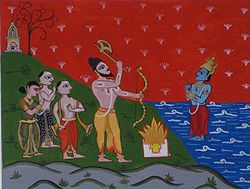- Kanara
-
The Kanara or Canara region (Kannada/Tulu: Karavali ಕರಾವಳಿ & Konkani:करावली ) comprises three coastal districts of Karnataka, namely Dakshina Kannada, Udupi and Uttara Kannada and Kasaragod district of Kerala in southwestern India. Kanara forms the southern part of the Konkan coast. The length of this region from north to south is around 300 km and width varies from 30 km to 110 km. The region is characterised by swaying palms and swift brooks running towards the Arabian Sea.
Contents
Etymology
According to legend Parashurama, the avatar of Vishnu, retrieved this place from the sea by throwing his axe into the sea. The sea fell back to the place where his axe fell. Hence this place is also called Parshurama Kshetra.
According to Historian Severino da Silva in his book History of Christianity in Canara vol. I, he mentioned that ancient names for this region are Kol Kannam (Tamil: no man's land) or Parashuram Srashti (creation of Parashuram).[1] According to Mr. Severine Silva, a former advocate at Karwar and Stephen Fuchs author of the work The Marriage Customs of the Christians in South Canara, India The name Canara is the invention of European traders (Portuguese, Dutch and English) who for the purpose of trade came to this tract from the early 16th century onwards. The Bednore Dynasty, under whose rule this tract was at that time, was known to them as the Kannada Dynasty, i.e., the dynasty speaking the Kannada language. The letter 'd' being always pronounced like 'r' by the Europeans, the district was named by them Kanara (or Kannada). This name was retained by the British after their occupation of the district in 1799, and ever since this name has remained. However according to them the controversy over the meaning of the place-name 'Canara' does not end with this explanation. It is a complicated question which cannot be discussed here.[2]
History
One of the main indigenous groups of this district are called Tuluva, probably from the word Tulavu which in Tulu language means - to row (the boat), since most of the early settlements of Tuluvas were on the banks estuary or rivers. It is impossible to state at what period this name was introduced; but it is certain that it came into existence only after the coastal strip of Canara was reclaimed from the sea and populated. The people who first settled here were called Tuluvas. Since very little research has been done about the prehistory of Canara, it is difficult to know who the earliest inhabitants of Tuluva were. Tuluvas probably migrated to this region from North western India around 1500 B.C.[3]
Geography
Coordinates: 14°53′N 74°35′E / 14.883°N 74.583°E
The three districts in the region are Uttara Kannada (North Canara) whose administrative headquarters is Karwar, Udupi district whose district headquarters is Udupi, and Dakshina Kannada (South Canara), whose administrative headquarters is Mangalore. The region is bounded on the east by the Western Ghats and on the west by the Arabian Sea. The coastal strip between the Western Ghats and the sea, including Kanara and the state of Goa and coastal Maharashtra to the north, is known as the Konkan coast, while the coast of Kerala is known as the Malabar coast. Kanara is also known as the Karavali coast.
Culture
Even though many languages are spoken here including Kannada,Tulu and Konkani there are many common factors in food, culture, rituals, traditions. Rice, fish and coconut oil are commonly used ingedients in the food of the people of Karavali region. Spirit worship (Bhuta Kola), Serpent worship (Nagaradhane), Buffalo race (Kambala), Yakshagana are some of common traditional rituals followed. Major ethnic groups are the Kannadigas,Tuluvas and Konkanis .
The main languages spoken in this area are Kannada,Tulu and Konkani. Konkani is mainly spoken in the northern part while Tulu is predominantly spoken in the south.But language Kannada is predominantaly spoken in the Taluk of Kundapur in Udupi district & in the major parts of Uttara Kannada District. The majority of the people follow Hinduism. Other religions practiced include Christianity and Islam. Tulu speakers are exclusively Hindus. This region has many sites of Hindu pilgrimage including Kollur, Dharmasthala, Udupi Srikrishna Muta (Temple), Kateel, Murdeshwara, Idagungi and Gokarna.
occupation
The main occupation of the natives is farming and fishing. Fish is the staple diet of the people living in this region. Coconut is used generously in all the dishes. The region has abundant rainfall, recording average annual rainfall among the highest in India.
Commerce
This region is also known as 'the cradle of Indian banking'. Konkan railway runs through the length of this region. The largest railway terminus in this region is at Mangalore. There are two major ports, New Mangalore Port and Karwar. The only airport in this region is Mangalore International Airport, with air connections to major cities in India and the Middle East. The southern part of this region is one of the most industrialised regions of Karnataka, with Karnataka's only petroleum refinery, iron ore pelletisation plants, steel plants, and fertiliser plants.
Demand for Statehood
The demand for creation of a separate state of Tulu Nadu, a prosperous region of Karnataka and Kerala, is based on fact that Tuluvas are culturally very distinct from the rest of Karnataka. Spirit worship (Bhuta Kola), Serpent worship (Nagaradhane) are can see only in Tulunadu. So this Tuluvas have been demanding a separate state, or at least autonomy. Both the Karnataka and Kerala state governments have created Tulu Sahitya Academy- for the preservation and promotion of Tuluva culture, and to counter this accusation of cultural neglect. [4]
See also
- North Canara
- South Canara
Notes
References
- Silva, Severine; Stephen Fuchs (1965) (PDF, 2.48 MB). The Marriage Customs of the Christians in South Canara. 2. 24. Asian Folklore Studies, Nanzan University (Japan). https://www.nanzan-u.ac.jp/SHUBUNKEN/publications/afs/pdf/a173.pdf. Retrieved 2009-04-23.
- Silva, Severine (1961). History of Christianity in Canara. I. Coompta, North Canara: Star of Kanara Press.
External links
Categories:- Regions of Karnataka
Wikimedia Foundation. 2010.

